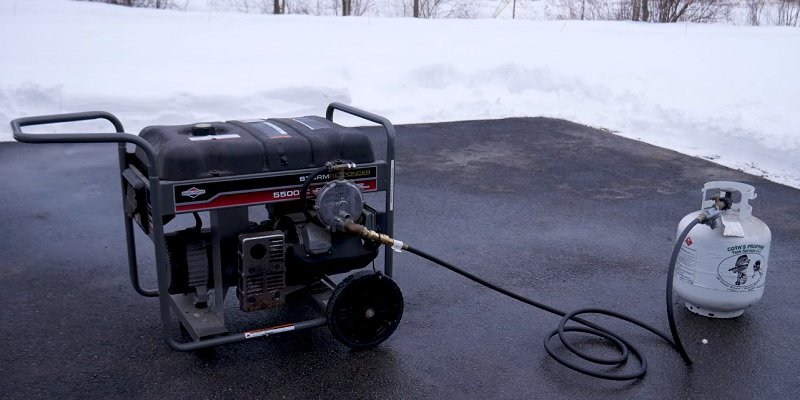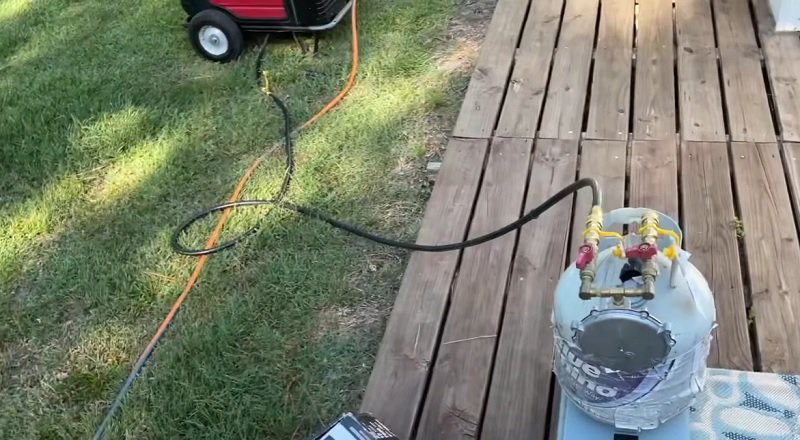Disclosure: This post contains affiliate links and I will be compensated if you make a purchase after clicking through my links. Learn More
The size of the propane line for a generator depends on the generator’s BTU rating and distance from the propane source. Typically, a 3/4 inch line suffices for most residential generators.
Selecting the right propane line size for your generator is crucial for optimal performance and safety. The line must accommodate the generator’s BTU requirements and the distance from the propane tank to ensure adequate fuel flow. Incorrect sizing can lead to inefficient operation or even damage to the generator.
It’s essential to consult the generator’s manual or a professional to determine the exact specifications needed. Proper installation not only ensures reliable power but also prevents potential hazards. Always prioritize safety and efficiency when setting up your generator’s propane line.

Basics Of Propane Lines
Choosing the right propane line size for your generator is important. Proper sizing ensures safety and efficiency. Understanding the basics of propane lines can help you make an informed decision.
Types Of Propane Lines
There are various types of propane lines available. Here are the most common ones:
- Flexible Propane Hoses: These are easy to install and flexible. They are ideal for small generators.
- Rigid Propane Pipes: These offer durability and strength. They are suitable for larger setups.
- Polyethylene Tubing: This type is lightweight and resistant to corrosion. It is often used for underground installations.
Material Considerations
The material of the propane line plays a crucial role in its performance. Here are some material considerations:
| Material | Benefits | Drawbacks |
|---|---|---|
| Copper | Flexible and easy to install | Can corrode over time |
| Stainless Steel | Highly durable and rust-resistant | More expensive than other materials |
| Polyethylene | Lightweight and corrosion-resistant | Can be damaged by sharp objects |
Consider these materials based on your generator’s needs. Each material has its own set of benefits and drawbacks.
Factors Influencing Line Size
Choosing the right propane line size for your generator is vital. Proper line size ensures efficient and safe operation. Several factors influence the size of the propane line. Let’s explore these factors to help you make an informed decision.

Generator Size
The size of your generator is a crucial factor. Larger generators need more propane to function properly. Smaller generators require less propane. The generator’s power output determines the propane flow rate. Ensure you know the wattage of your generator.
Distance From Tank
The distance between the generator and the propane tank impacts line size. Longer distances require larger lines. This prevents pressure drops and ensures a steady flow. Measure the distance from your tank to your generator accurately.
| Distance (Feet) | Recommended Line Size (Inches) |
|---|---|
| 0 – 25 | 1/2 |
| 26 – 50 | 3/4 |
| 51 – 100 | 1 |
Calculating Propane Line Size
Choosing the right propane line size for your generator is crucial. The correct size ensures your generator runs efficiently and safely. This section covers how to calculate the necessary propane line size.
Flow Rate Calculation
First, determine the flow rate of propane needed by your generator. The flow rate is the amount of propane gas that moves through the line per hour. Check your generator’s manual for the required flow rate. It is usually measured in Cubic Feet per Hour (CFH) or BTU/hr.
Here is a simple formula to convert BTU/hr to CFH:
CFH = BTU/hr ÷ 2488For example, if your generator requires 50,000 BTU/hr:
CFH = 50,000 ÷ 2488 ≈ 20.1 CFHPressure Drop
Next, consider the pressure drop in the propane line. Pressure drop is the loss of pressure as propane moves through the line. Too much pressure drop can affect the generator’s performance.
Several factors affect pressure drop:
- Length of the propane line
- Diameter of the propane line
- Number of bends or fittings in the line
Use the following table to estimate pressure drop based on line length and flow rate:
| Line Length (ft) | Flow Rate (CFH) | Pressure Drop (inches of water column) |
|---|---|---|
| 10 | 20 | 0.5 |
| 25 | 20 | 1.2 |
| 50 | 20 | 2.5 |
| 100 | 20 | 5.0 |
Ensure the pressure drop remains within safe limits for your generator. Most generators can handle a pressure drop of 1-3 inches of water column.
Installing Propane Lines
Installing propane lines for your generator is crucial. It ensures a safe and efficient setup. This section guides you through the installation process.
Safety Precautions
Safety precautions are vital when installing propane lines. Follow these steps to keep your installation safe:
- Turn off the main gas supply before starting.
- Wear protective gloves and eyewear.
- Use a gas leak detector to check connections.
- Ensure proper ventilation in the work area.
Always prioritize safety. Proper precautions prevent accidents and ensure a smooth installation.
Step-by-step Guide
Follow this step-by-step guide to install your propane lines correctly:
- Measure the distance between the propane tank and the generator. This ensures you get the correct line size.
- Choose the right propane line size. Consult the generator’s manual for specifications.
- Cut the propane line to the required length. Use a pipe cutter for a clean cut.
- Connect one end of the line to the propane tank. Ensure the connection is tight.
- Connect the other end to the generator’s inlet. Again, ensure the connection is secure.
- Check all connections with a gas leak detector. This step is crucial for safety.
- Turn on the main gas supply and test the generator. Ensure it runs smoothly with no leaks.
By following this guide, you can install propane lines safely and efficiently.
Regulations And Codes
Understanding the regulations and codes for propane lines is crucial. These rules ensure safety and efficiency. They also help you avoid fines and issues.
Local Building Codes
Local building codes are specific to your area. These codes vary by region. They define how to install propane lines safely. Always check your local codes before starting.
Inspectors will check your work. They ensure everything meets the code. Failure to comply can result in fines. It can also pose safety risks.
Here are key points to consider:
- Check with your local building department.
- Get any necessary permits.
- Ensure the line size meets local requirements.
Industry Standards
Industry standards offer a guide for safe propane line installation. These standards are developed by experts. They ensure safety and efficiency across the board.
The National Fire Protection Association (NFPA) provides guidelines. The NFPA 58 is a key document. It outlines the requirements for propane systems.
Key points from industry standards include:
- Use the correct material for propane lines.
- Ensure proper line sizing for your generator.
- Follow installation practices to prevent leaks.
Below is a table summarizing important standards:
| Standard | Description |
|---|---|
| NFPA 58 | Guidelines for propane systems |
| NFPA 54 | National Fuel Gas Code |
| ANSI Z223.1 | Gas piping systems and installations |
Following both local building codes and industry standards ensures safety. It also helps your generator run efficiently.
Common Problems And Solutions
Choosing the right size propane line for your generator is crucial. Mistakes can lead to various issues that affect performance and safety. Let’s explore some common problems and their solutions.
Undersized Lines
An undersized propane line can cause serious problems. The generator may not receive enough fuel. This leads to poor performance and potential shutdowns.
To solve this, check the manufacturer’s guidelines. They provide the recommended line size. Ensure the line matches the generator’s fuel requirements.
Use the following table to understand the recommended line sizes:
| Generator Power (kW) | Recommended Propane Line Size (inches) |
|---|---|
| Up to 10 kW | 3/4 inch |
| 10 to 20 kW | 1 inch |
| 20 to 30 kW | 1 1/4 inches |
Leaks And Inspections
Propane leaks are dangerous and must be addressed immediately. Regular inspections can prevent leaks. Look for signs such as a rotten egg smell or hissing sound.
Follow these steps to inspect for leaks:
- Turn off the propane supply.
- Mix soap and water in a spray bottle.
- Spray the mixture on the propane line and fittings.
- Look for bubbles forming, indicating a leak.
If you find a leak, tighten the fittings or replace the damaged parts. Always prioritize safety when dealing with propane.
Maintenance Tips
Maintaining your propane line for a generator is crucial. Regular upkeep ensures safety and efficiency. Below are some essential maintenance tips.
Regular Inspections
Regular inspections are key to a safe propane line. Check for leaks and wear. Use soapy water to spot leaks. Turn off the propane and apply soapy water to connections. Bubbles indicate a leak. Replace faulty parts right away.
Inspect the line for damage or cracks. Use a flashlight to look closely. Ensure the line is free from obstructions. Clear any debris to keep it clean.
Seasonal Checkups
Seasonal checkups prepare your propane line for changing weather. Check the line before winter and summer. Cold weather can cause contraction. Warm weather can cause expansion. Both can lead to leaks or damage.
Check the propane level in the tank. Ensure it is sufficient for the season. Clean the line and connections. Remove dirt or moisture to prevent corrosion. Schedule a professional checkup once a year.
Below is a table summarizing the seasonal checkup tasks:
| Season | Task |
|---|---|
| Winter | Check for contraction, inspect for leaks, ensure enough propane |
| Summer | Check for expansion, inspect for leaks, clean line |
Following these tips ensures your propane line stays safe and efficient.
Frequently Asked Questions
What Size Propane Line For Generator?
The size depends on generator’s BTU rating. Typically, 3/4-inch or 1-inch lines are common.
How To Determine Propane Line Size?
Check the generator’s manual. It usually specifies the required propane line size based on BTU output.
Can I Use A Smaller Propane Line?
Using a smaller line can restrict fuel flow. This might result in poor generator performance.
Is Professional Installation Necessary?
Yes, professional installation ensures safety and proper line sizing, preventing potential hazards and inefficiencies.
Final Thoughts
Choosing the right propane line size is crucial for your generator’s efficiency. Consult a professional to ensure safety. Proper sizing prevents leaks and ensures reliable power. Always follow manufacturer guidelines for the best results. Prioritize safety and performance to keep your generator running smoothly.


